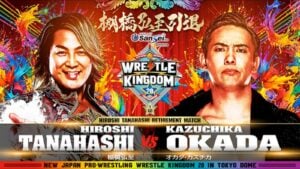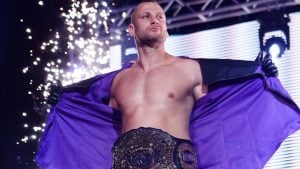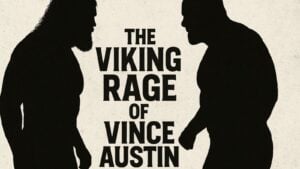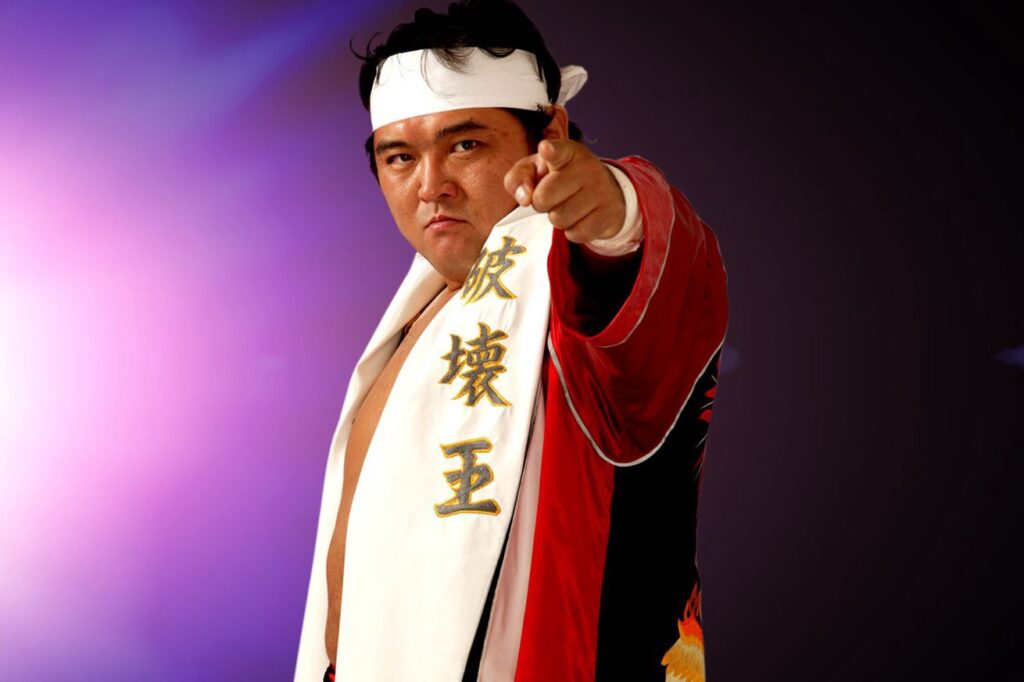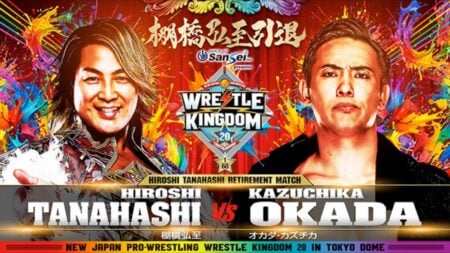Shinya Hashimoto had one of the most interesting careers in Japanese history. He was one of the biggest draws ever prior to WWE’s explosive success from the late 1990s to the present.
He sold out the cavernous Tokyo Dome many times. His home promotion, New Japan Pro-Wrestling, made millions in profit thanks to Hashimoto’s work. And this was without much of a TV presence and a nearly non-existent PPV mechanism.
He was to NJPW what Roman Reigns has become for WWE. And yet, his career ended in both professional and personal tragedy. How did this happen? Let’s find out by revisiting Hashimoto’s stellar career.
Shinya Hashimoto – Handpicked for success
Hashimoto began wrestling professionally when he was nineteen years old after spending years training in judo and karate. That background was crucial for both Hashimoto and New Japan because of NJPW’s style.
Owner Antonio Inoki had a vision of his company’s style. NJPW’s “Strong Style” was all about realism, legitimacy, and martial prowess. To that end, martial artists and technical specialists were prized above brawlers and storytellers.
And while Hashimoto wasn’t very technical, he was a great striker. Like Yuji Nagata before him and his AJPW equivalent Toshiaki Kawada, Hashimoto was a stiff and brutal striker that specialized in kicks.
He was so good at this that he was able to pull double duty between 1990 and 1998. During that period, Hashimoto participated in “different style fights”, which was a fancy way of saying ‘wrestler vs. non-wrestler/fighter’.
He achieved mild success in these matches, but they helped elevate his reputation. He won many accolades throughout the early-to-mid 1990s, including tag titles and tournament wins.
Peak
Hashimoto reached his peak as a wrestler between 1995 and the end of 1998. By that point, Hashimoto had become NJPW’s unquestioned ace. And as ace, one of his responsibilities was to defend NJPW’s honor against outsiders.
Inoki struck gold with the classic ‘outside invaders’ angle and used it time and again. The best one he did was when NJPW was invaded by the Union of Wrestling Forces International (UWFi).
That fledging company was built on ‘shootfighting’ and contained pioneers of MMA like Masakatsu Funaki and Minoru Suzuki.
The UWFi was led by Nobuhiko Takada, himself a former New Japan trainee. But Takada found more success outside New Japan and then came back in one of the biggest wrestling shows ever.
On April 29th, 1996, Takada lost the IWGP Heavyweight Championship to Hashimoto after beating another NJPW loyalist Keiji Mutoh months earlier.
Takada’s match with Hashimoto set a financial record, drawing a gate of the equivalent of $5.7 million US. Keep in mind that this was without PPV and with a much smaller TV presence compared to WWF/E and WCW at the time.
After winning the IWGP Heavyweight title from Takada, Hashimoto held it for 489 days. His record stood for almost twenty years until it was eclipsed by Kazuchika Okada. But despite losing, Hashimoto remained at the top of New Japan for two years.
Even though he wasn’t getting all the accolades and critical acclaim as his AJPW counterparts, he was raking in money for New Japan hand over fist. All Japan might’ve had the better matches, but New Japan under Hashimoto had greater profits.
Hashimoto achieved considerable success and was considered almost untouchable as the biggest of New Japan’s Three Musketeers.
And then his career took an absolute nosedive.
Shinya Hashimoto – Betrayal
On January 4th, 1999, the English-speaking wrestling world was celebrating Mick Foley’s big WWE title win. Meanwhile, in Japan, a massive scandal was erupting following what could be best described as ‘a worked match turned shoot fight’.
For two years, Hashimoto had been embroiled in an on-again-off-again feud with Naoya Ogawa. Ogawa was an Olympic-level judoka and had won many championships in that combat sport.
Ogawa was being groomed as Inoki’s pet project and his future ace. But unlike Kensuke Sasaki before him, Ogawa wasn’t much of an ‘entertainer’. He was a ‘pure sportsman’ in the sense that he was all about the sport and not about the showmanship.
And even though the sports-centric presentation was central to Inoki’s Strong Style, New Japan fans still wanted wrestling as entertainment. But Inoki wanted Ogawa as his new star and was hellbent on getting him over no matter what.
Thus a match was scheduled for New Japan’s annual January 4 Dome Show. Chris Charlton’s book Eggshells: Pro Wrestling in the Tokyo Dome provides an excellent and detailed account of this event. We’ll just provide the cliff’s notes version of what happened.
Hashimoto went into that match cautious but confident that it was going to be a wrestling match. He had been told that “nothing weird’s going on tonight” by a representative of UFO, an Inoki side project centered on MMA and included Ogawa.
But that’s not necessarily what Ogawa was told. Nothing has ever been confirmed 100%, but one rumor still swirls to this day and is considered the closest thing to fact.
That rumor states that Inoki ordered Ogawa to “do as much to Hashimoto as he could get away with, the controversy benefitting everyone in the long run”.
Ogawa took this order to mean “beat the ever-loving s**t out of Hashimoto for real.” And that’s exactly what Ogawa did. He pummeled Hashimoto so badly that a few NJPW staff and witnesses believed Ogawa was going to kill Hashimoto.
The fans were incensed at the angle. That blurring of the line between scripted and reality became the cornerstone of the ‘Inokism’ era of New Japan. That era saw many wrestlers’ career sacrificed at the altar of MMA.
Pro wrestlers, untrained in MMA, were exposed in genuine MMA fights. Conversely, MMA fighters, untrained in the art of pro-wrestling, struggled to live up to expectations in wrestling matches.
But no wrestler suffered from this philosophy of Inoki’s more than Hashimoto. He had spent years cultivating a reputation and aura of badassery.
He was considered New Japan’s toughest fighter, their most credible athlete, and the one that could always be relied on to defend the company from outsiders thinking they could beat New Japan and its Strong Style. Ogawa made him look like a complete chump.
Hashimoto’s reputation was shattered beyond salvation. No matter what he did, his image as NJPW’s toughest wrestler was damaged irreparably. Even if he got revenge on Ogawa, his status would never be the same.
This was the New Japan version of the Montreal Screwjob: the company’s biggest star had his career tarnished by the company owner stubbornly wanting to go in a specific direction and thus sacrificed that biggest star in order to do so.
Shinya Hashimoto – Final years
Like Bret Hart, Hashimoto’s career winded down in a disappointing way. He left New Japan on poor terms and founded his own company, Pro Wrestling Zero1. Hashimoto spent his final years there and wrestled some big cross-promotional matches in All Japan and Pro Wrestling NOAH.
And like Bret, Hashimoto suffered a major health issue after retiring from wrestling. But Bret (thankfully) survived his; Hashimoto, unfortunately, didn’t.
Eight days after his 40th birthday, Hashimoto suffered a fatal brain aneurysm. His doctors claimed it stemmed from high blood pressure brought about by stress and the accumulation of several injuries over his 20-year wrestling career.
Shinya Hashimoto – Legacy
Shinya Hashimoto was one of the biggest draws in the entire wrestling world during the 1990s. He was as close to a perfect combat sports athlete as one could get in wrestling. He was a no-nonsense (literal) a**-kicker that kept things simple.
Shinya Hashimoto kicked people brutally hard, used realistic submission holds, and did one of the best Brainbusters the industry has ever seen.

He wasn’t someone that needed to do flashy moves and over-the-top acrobatics. He was a martial artists that thrived in a wrestling company that prided itself on being ‘real’.
Hashimoto sold out large venues for years and, at one point, co-main-evented the most financially-successful wrestling show in history.
He was very much the Japanese version of known modern WWE aces like John Cena and Roman Reigns.
Even though he wasn’t the best in-ring wrestler, he was good enough that people believed in him and were willing to spent their hard-earned money to see him compete in big matches.
He had great matches throughout the 1990s with a bevy of skilled wrestlers. For those looking to see his best matches, we’ve found a few worth watching:
- Hashimoto vs. Kazuo Yamazaki – NJPW G1 Climax 1998, August 2nd, 1998
- Shinya Hashimoto vs. Genichiro Tenryu – WAR Revolution Yojo, June 17th, 1993
- Hashimoto vs. Nobuhiko Takada – NJPW Battle Formation in Tokyo Dome, April 29th, 1996
- Hashimoto vs. Hiroshi Hase – December 13th, 1994
- Shinya Hashimoto vs. Lord Steven Regal – NJPW Battle Rush 1995, April 16th, 1995
- Hashimoto vs. Keiji Mutoh – NJPW G1 Climax 1995, August 15th, 1995
- Hashimoto vs. Toshiaki Kawada – AJPW Excite Series, February 22nd, 2004
At the same time, there’s a lesson to be learned from Hashimoto’s career. The lesson is that a wrestler’s career can be destroyed beyond repair in a single moment. The January 4 Incident with Naoya Ogawa ruined Hashimoto and he never recovered.
He was betrayed by the company he was loyal to because the company owner wanted to build an angle on controversy instead of professionalism.
This goes to show you that promoters backstabbing their wrestlers and playing God with their wrestlers’ lives and careers isn’t unique to American wrestling companies.
